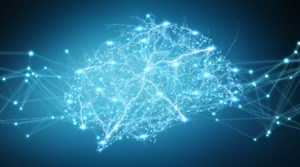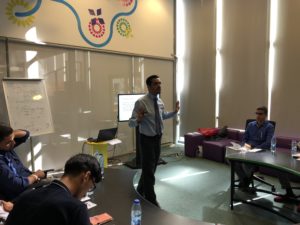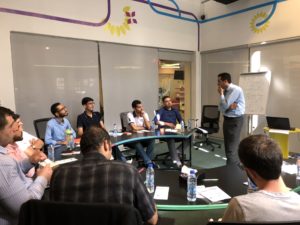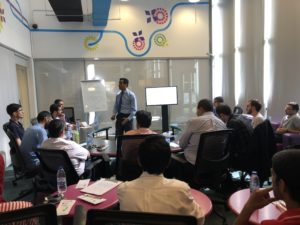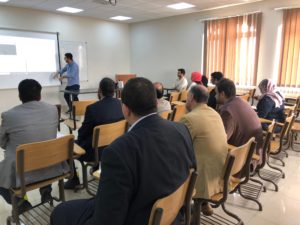Deep Learning: A Signal Processing Perspective
Location: Zoom!
Date: 22 March 2021
Abstract:
The signal processing (SP) landscape has been enriched by recent advances in artificial intelligence (AI) and machine learning (ML), especially since 2010 or so, yielding new tools for signal estimation, classification, approximation, and manipulation. Layered signal representations, nonlinear function approximation, and nonlinear signal prediction are now feasible at very large scale in both dimensionality and data size. These are leading to significant performance gains in a variety of long standing problem domains (e.g., speech, vision), as well as providing the ability to construct new classes of nonlinear functions (e.g., fusion, nonlinear filtering). In this talk we look at the rapid evolution of signal processing tools and techniques, their strengths and weaknesses, and consider emerging frontiers. From a fundamental SP perspective, open questions include robustness, adaptivity, and performance analysis. Embedding the new techniques into emerging architectures will very likely provide new systems-level solutions for a variety of applications, taking advantage of their strengths while surmounting inherent weaknesses.
Speaker’s (short) Bio:
 Brian M. Sadler was an IEEE Signal Processing Society Distinguished Lecturer for 2017-2018, and is an IEEE Communications Society DL for 2020-2021. He is the Army Senior Scientist for Intelligent Systems at the Army Research Laboratory (ARL) in Adelphi, MD, is a Fellow of ARL, and a Fellow of the IEEE. He has been an associate or guest editor for a variety of journals including the IEEE Transactions on Signal Processing, EURASIP Signal Processing, IEEE SP Letters, IEEE SP Magazine, IEEE Transactions on Robotics, International Journal of Robotics Research, and Autonomous Robots. He received Best Paper Awards from the IEEE Signal Processing Society in 2006 and 2010, several ARL and Army R&D awards, and a 2008 Outstanding Invention of the Year Award from the University of Maryland. His research interests include information science, networked and autonomous systems, human-machine teaming, sensing, and mixed-signal integrated circuit architectures, and he has 450 publications in these areas with more than 16,800 citations and h-index of 55.
Brian M. Sadler was an IEEE Signal Processing Society Distinguished Lecturer for 2017-2018, and is an IEEE Communications Society DL for 2020-2021. He is the Army Senior Scientist for Intelligent Systems at the Army Research Laboratory (ARL) in Adelphi, MD, is a Fellow of ARL, and a Fellow of the IEEE. He has been an associate or guest editor for a variety of journals including the IEEE Transactions on Signal Processing, EURASIP Signal Processing, IEEE SP Letters, IEEE SP Magazine, IEEE Transactions on Robotics, International Journal of Robotics Research, and Autonomous Robots. He received Best Paper Awards from the IEEE Signal Processing Society in 2006 and 2010, several ARL and Army R&D awards, and a 2008 Outstanding Invention of the Year Award from the University of Maryland. His research interests include information science, networked and autonomous systems, human-machine teaming, sensing, and mixed-signal integrated circuit architectures, and he has 450 publications in these areas with more than 16,800 citations and h-index of 55.
We thank Mr. Sadler for permitting us to publish the video of the talk. Enjoy!
Spectrum Sensing in Cognitive Radio
Location: Hussain Business Park
Date: 4 Aug 2018
Abstract:
Cognitive radio (CR) is considered as an intelligent technology and an important part of the next fifth generation wireless systems. It promises a great utilization of the radio spectrum, and it enables more subscribers to access the network and exchange data. CR is a communication system that has the ability to make self-decisions in order to connect its subscribers (secondary users (SUs)) to the network whenever there is a particular section of the spectrum that is unoccupied by primary users (PUs) to use it for data exchange. In addition, it has to be capable of predicting whenever a PU is going to utilize the spectrum band (spectrum sensing), which means the SU should leave the band, for the purpose of not disturbing the PU. Alternatively, the CR must maintain a good quality of service (QoS) level for its users by finding other opportunities for them to continue their activities. The SUs of the cognitive radio are named as such because they, unlike the PUs, do not have the right for spectrum band access at any given time, since the PU paid for the right of accessing the band at any given time in the first place. Therefore, the SU gains access to the band if the PU is not occupying it, or when the PU itself allows the SU to share the band, given that the SU will not disturb the activity of the PU in any sort of way. Spectrum sensing is almost a continuous process during the life cycle of cognitive radio communications. Sensing must be done initially to find an idle channel, and then it must be done periodically to protect the PU when he decides to use his licensed channel again. In this case, sensing is invoked again to find a different idle channel. Therefore, reducing sensing time increases the room left for transmission and consequently achieves the main goal of CR in increasing the utilization of the wireless spectrum. In fact, sensing does not only allow CR nodes to use the idle licensed channels, but also plays an important role in protecting the PU from interference. Thus, sensing has received a lot of attention in CR in the research community. Technically, the sensing process implies detecting the existence of a primary transmitter on a specific channel. The CR nodes are allowed to use the PU’s channels if they can identify the channel as idle. Otherwise, the CR nodes back off to allow the PU to use its channel with no interference.
Speaker:
 Ghazi AL SUKKAR received his Ph.D degree in Electrical and Computer Engineering/Wireless communication networks from Telecom Sudparis previously known as Institut National des Telecommunications, Paris, France in 2008. He received his M.Sc. degree in Telecommunications engineering from The University of Jordan, Amman, Jordan, in 2003 and the B.Sc degree in electrical engineering/Telecommunications from Jordan University of Science and Technology, Irbid, Jordan, in 2000. He joined the Department of Electrical Engineering at the University of Jordan in 2009. His current research focuses on various aspects of wireless communication networks including Wireless sensors, Mesh, Vehicular and P2P networks, Cognitive Radio Networks, LTE-Advanced, with emphasis on system architecture and communication protocol design. Other interests include digital signal processing, and traffic simulation.
Ghazi AL SUKKAR received his Ph.D degree in Electrical and Computer Engineering/Wireless communication networks from Telecom Sudparis previously known as Institut National des Telecommunications, Paris, France in 2008. He received his M.Sc. degree in Telecommunications engineering from The University of Jordan, Amman, Jordan, in 2003 and the B.Sc degree in electrical engineering/Telecommunications from Jordan University of Science and Technology, Irbid, Jordan, in 2000. He joined the Department of Electrical Engineering at the University of Jordan in 2009. His current research focuses on various aspects of wireless communication networks including Wireless sensors, Mesh, Vehicular and P2P networks, Cognitive Radio Networks, LTE-Advanced, with emphasis on system architecture and communication protocol design. Other interests include digital signal processing, and traffic simulation.
INTRODUCTION TO WIRELESS COMMUNICATIONS USING SOFTWARE DEFINED RADIOS
Location: Al-Zaytoonah University of Jordan
Date: 25 April 2018
Abstract:
This seminar topics include: We will physically setup and plug in a USRP, write a program in LabVIEW, and then visualize the results.
- Wireless Signal Acquisition.
- Physically setup and plug in NI-USRP SDR.
- Program in LabVIEW.
- Visualize the wireless signal.
Speaker:
Eng. Mounzer Saleh
Academic Field Engineer at National Instruments


